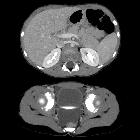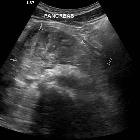Pankreastrauma
















The pancreas is uncommonly injured in blunt trauma. However, pancreatic trauma has a high morbidity and mortality rate. Imaging features range from subtle to obvious.
Epidemiology
The pancreas is injured in ~7.5% (range 2-13%) of blunt trauma cases . Motor vehicle accidents account for the vast majority of cases.
Clinical presentation
The classic triad of fever, raised white cell count, and amylase is rare. Serum amylase or lipase are elevated in ~80% of cases but distinguishing between a raised amylase or lipase as an acute phase reactant or resulting from a pancreatic injury is difficult.
Pathology
The pancreatic body accounts for two-thirds of injuries with ~10% occurring each in the head, neck and tail .
The pancreas is prone to crush injuries of the vertebral column :
- pancreatic laceration: partial thickness tear of the pancreas
- pancreatic transection: full thickness tear of the pancreas
- pancreatic comminution (fracture): shattered pancreas
- pancreatic hematoma
- pancreatic pseudocyst
Grading
See main article: grading of pancreatic injuries.
Associations
It is uncommonly (<10%) an isolated injury and other organs that are also injured include:
Radiographic features
Fluoroscopy
- ERCP can also be used to image the pancreatic duct and any associated injury, although it's main role is to provide access to stent the pancreatic duct when injury is confirmed by MRCP
CT
- direct signs
- hypodense laceration or comminution of the pancreatic parenchyma
- heterogeneous parenchymal enhancement
- enlargement of the pancreas
- fluid collections (pseudocyst, abscess or hematoma) communicating with the pancreatic duct
- secondary signs
- peripancreatic fat stranding, fluid or hematoma between the pancreas and splenic vein
- peripancreatic fluid
- thickening of Gerota’s fascia
- injury to the pancreatic duct may not be seen directly but is inferred by the grading of the injury
MRI
- MRCP can be used to image the pancreatic duct and any associated injury
Treatment and prognosis
Delayed diagnosis raises both the mortality and morbidity of traumatic pancreatic injuries, both of which are high, with a mortality rate of up to 20% .
Injuries with pancreatic duct disruption are more likely to undergo endoscopic stenting whereas surgical intervention is preferred for injuries not involving the pancreatic duct .
Complications
Complications of pancreatic trauma occur in up to 20% of patients and include:
- pancreatitis: occurs in ~7.5% (range 6-10%)
- fistula (more common with pancreatic duct disruption)
- abscess and sepsis (more common with pancreatic duct disruption)
- hemorrhage
- pancreatic pseudocyst
Differential diagnosis
- pancreatitis
- pseudopancreatitis
- pancreatic clefts which are most prominent at the junction of the body and neck
Siehe auch:
- Milzruptur
- stumpfes Bauchtrauma
- Leberblutung
- posttraumatische Pankreatitis
- traumatische Magenruptur
- Pankreastrauma Gradeinteilung
- Pankreasruptur mit Pseudozystenbildung
und weiter:

 Assoziationen und Differentialdiagnosen zu Pankreastrauma:
Assoziationen und Differentialdiagnosen zu Pankreastrauma:



